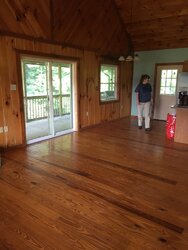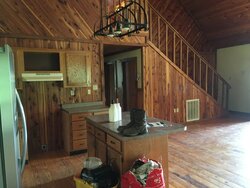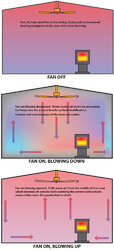The "bunk house" has a OWF but i'm worried about a heat source as a backup if we lose power so I'm thinking about a actual wood stove. Cook, heat and atmosphere that could use the same wood we'd have on hand for the OWF.
I haven't done any research but I hate this ventless gas thing that has zero character and is really expensive to run. It uses a lot of gas and doesn't have a blower so it heats a corner of the house and is virtually useless to get heat to other parts of the house.
The house was designed by caretakers that had been state park camp hosts. We have a vaulted ceiling in the main room that includes a common room, dining room with table and kitchen all-in-one. The bedrooms are in the back of the house with two down and one upstairs. I consider this floor plan a "difficult to heat" layout that has lots of character and looks a lot like a hunting shack/state park cabin with wrap around porch. The living space is about 1600 square feet.
I appreciate any advice about how to resolve this confusing and complicated issue.
I haven't done any research but I hate this ventless gas thing that has zero character and is really expensive to run. It uses a lot of gas and doesn't have a blower so it heats a corner of the house and is virtually useless to get heat to other parts of the house.
The house was designed by caretakers that had been state park camp hosts. We have a vaulted ceiling in the main room that includes a common room, dining room with table and kitchen all-in-one. The bedrooms are in the back of the house with two down and one upstairs. I consider this floor plan a "difficult to heat" layout that has lots of character and looks a lot like a hunting shack/state park cabin with wrap around porch. The living space is about 1600 square feet.
I appreciate any advice about how to resolve this confusing and complicated issue.





 ! I was forced to use a pipe for leverage to get the largest round from the base of the tree into position because I tipped it up too soon and it wasn't close enough to the footplate of the splitter. We worked it out and I learned a lot about splitting. I saved one of the smallest and straightest rounds for a chopping block for future use.
! I was forced to use a pipe for leverage to get the largest round from the base of the tree into position because I tipped it up too soon and it wasn't close enough to the footplate of the splitter. We worked it out and I learned a lot about splitting. I saved one of the smallest and straightest rounds for a chopping block for future use.